

HISTORY: Thinglink Exploring the American colonies. HISTORY: The History of Colonial America. HISTORY: Map of Colonial America. HISTORY: The Mississippi (map from French cartographer) HISTORY: Conquest of Mexico Paintings - Exploring the Early Americas. The Conquest of Mexico paintings are significant both artistically and historically.
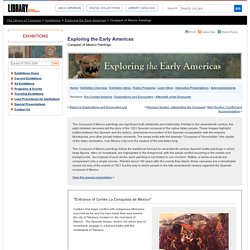
HISTORY: The Trans-Atlantic Slave Trade Uprooted Millions. HISTORY/ECONOMY: The Atlantic Slave Trade: Crash Course World History #24. ELAR: What is Settler-Colonialism (connecting past and present) ELAR: 5 Poems by Anne Bradstreet, Colonial American Poet. By Nava Atlas | On August 19, 2018 | Comments (0) Anne Bradstreet (1612 – 1672) was one of the most prominent early American poets, and the first writer in the American colonies to be published.
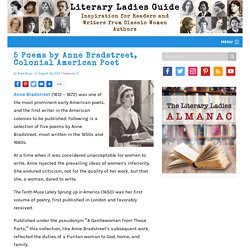
Following is a selection of five poems by Anne Bradstreet, most written in the 1650s and 1660s. At a time when it was considered unacceptable for women to write, Anne rejected the prevailing ideas of women’s inferiority. She endured criticism, not for the quality of her work, but that she, a woman, dared to write. The Tenth Muse Lately Sprung Up in America (1650) was her first volume of poetry, first published in London and favorably received.
Published under the pseudonym “A Gentlewoman from Those Parts,” this collection, like Anne Bradstreet’s subsequent work, reflected the duties of a Puritan woman to God, home, and family. She did so skillfully, and occasionally allowed notes of cynicism to creep in — perhaps the only form of rebellion possible for a woman of her time. ELAR: The Life of Plantation Field Hands (Analyze a Primary Source) Introduction James Stirling, was a British writer who visited the American South in 1857.
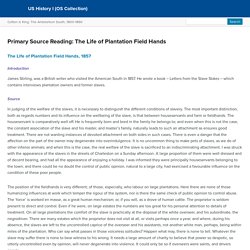
He wrote a book – Letters from the Slave States – which contains interviews plantation owners and former slaves. Source. ELAR: Frederick Douglass Describes Enslavers (Analyze a Primary Source) ELAR: Teach Dear America; Connecting Colonial America with the Dear America Historical Fiction Books. Colonial settlers came to America for many reasons.
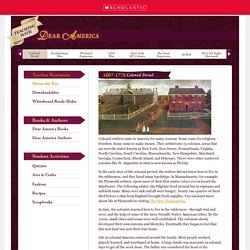
Some came for religious freedom. Some came to make money. They settled into 13 colonies, areas that are now the states known as New York, New Jersey, Pennsylvania, Virginia, North Carolina, South Carolina, Massachusetts, New Hampshire, Maryland, Georgia, Connecticut, Rhode Island, and Delaware. There were other scattered colonies like St. Augustine in what is now known as Florida. ECONOMICS: Introduction - Colonies in America: Commerce, Business, and the Economy - Res... This guide is intended for researchers interested in studying commerce and business during the Colonial period, defined for the purposes of this guide, as the time prior to the American Revolution.
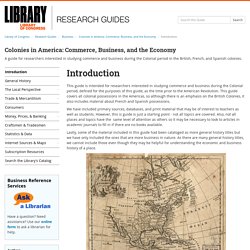
This guide covers all colonial possessions in the Americas, so although there is an emphasis on the British Colonies, it also includes material about French and Spanish possessions. We have included primary sources, databases, and print material that may be of interest to teachers as well as students. However, this is guide is just a starting point - not all topics are covered. Also, not all places and topics have the same level of attention as others so it may be necessary to look to articles in academic journals to fill in if there are no books available.
Lastly, some of the material included in this guide had been cataloged as more general history titles but we have only included the ones that are more business in nature. ECONOMICS: Money in Colonial Times - Philadelphia Fed. Home > Education > Resources for Teachers > Additional Resources > Money in Colonial Times Introduction A shortage of money was a problem for the American colonies.

England did not supply its colonies with sufficient coinage and prohibited them from making their own. The early settlers brought coins from Europe but they went quickly back there to pay for supplies. Without enough money, the colonists had to barter for goods or use primitive currency such as Indian wampum, nails, and tobacco. ECONOMICS: Without Slavery, Would The U.S. Be The Leading Economic Power? During the middle of the 1800s, cotton became the world's largest commodity.

The cheapest and best cotton came from the southern United States. Edward Baptist argues in his new book, "The Half Has Never Been Told: Slavery and the Making of American Capitalism," that the forced migration and subsequent harsh treatment of slaves in the cotton fields was integral to establishing the United States as a world economic power. "Slavery continues to have an impact on America in the most basic economic sense," Baptist told Here & Now's Jeremy Hobson.
"We don't want to hear that at its root, the economic growth depends to a large extent on slavery. " Book Excerpt: 'The Half Has Never Been Told' By Edward E. ECONOMICS: How Slavery Helped Build a World Economy. MATH: The Countries Most Active in the Trans-Atlantic Slave Trade (Graph) SCIENCE: How did geography affect the development of colonial America? SCIENCE: Southern Colonies Geography & Climate - Video & Lesson Transcript. SCIENCE: Middle Colonies Geography & Climate - Video & Lesson Transcript.
SCIENCE: New England Colonies Geography & Climate - Video & Lesson Transcript. In this lesson, we'll take a look at the development of the Northern Colonies.

We'll find that geography and climate actually played a large role in creating societies similar to those found back in Europe. SCIENCE: Colonial America's Pre-Industrial Age of Wood and Water (power sources) Colonial America's Pre-Industrial Age of Wood and Water More than 200 years ago, Moravian settlers created a community with an integrated industrial area along the Monocacy Creek in Bethlehem, Pennsylvania.

Greatly admired throughout the colonies, the industrial site bustled with activity. Today, Bethlehem's Colonial Industrial Quarter, which covers 10 acres, is the largest and most diverse pre-industrial revolution technology site under restoration in the Commonwealth—if not the nation. To understand the impact of pre-industrial revolution technology, we must first come to an understanding of what technology is. MUSIC: Federal Theatre Project, 1935 to 1939, Available Online, 1900/1999, The Disappointment (flrpd.06300001.0/) Collection Federal Theatre Project, 1935 to 1939 Results: 1-40 of 74 | Refined by: Part of: Federal Theatre Project, 1935 to 1939 Remove Available Online Remove Date: 1900 to 1999 Remove Look Inside: The Disappointment (flrpd.06300001.0/) Remove.
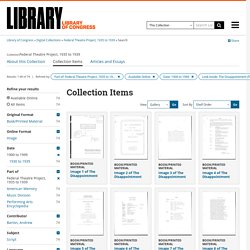
MUSIC: The Annual 4th of July Concert, 2018 in Sara Delano Roosevelt Park.